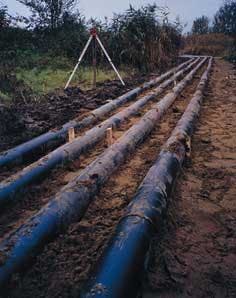Vacuum technology gains momentum
By Dr. György Fábry, Gergely Fábry
Photo by Iseki Vacuum Systems
The UK company Iseki Vacuum Systems installed more than 110 kilometres of vacuum sewers, connecting 7,000 houses to sewage collection networks in four villages and one town in Pest County, Hungary.
Located on the Great Hungarian Plain, the region is very flat with a high water table. More than half of the country's population centres are situated on the plain and "blessed" with high groundwater and sandy soil, conditions that make gravity sewer systems difficult and expensive to install and operate. Consequently, the Iseki vacuum approach has proven to be cost-effective and practical in this terrain.
Vacuum technology can operate in difficult environmental conditions. Laid in shallow trenches with flexible small bore pipes, it can accommodate minimum fall, obstructions in the path of the pipeline and inclines when necessary.
The soil volume mobilised during construction of the vacuum system is only 20% to 40% of that of a gravity system. This reduces noise and dust load, the excavator-running hours, the disturbance of the neighbourhood, and the number of soil-carrying trucks in two directions.
Gravity systems generally require more pump stations installed at depths down to five feet. It is usually sufficient to build one three-metre-deep vacuum collection station in a vacuum system with the discharge function. The volume of soil excavated for this reason is much smaller than in the case of gravity-system pump stations.
Gravity pipework, due to its depth, spigot and socket pipe joints and strict slope requirements is not flexible as far as horizontal and vertical profiles are concerned, so in general it must be built under the axis of the road causing large-scale asphalt breaking, excavation and reinstatement.
The flexible horizontal and vertical profile (due to the hydraulic characteristics of the vacuum sewerage system) together with the "easy to lay down" advantages of the welded polyethylene (PE) pipework and the small trench sizes jointly result in several benefits. Pipework can be installed out of the road axis, normally in the verge or pavement. In this case, asphalt breaking and reinstatement are minimal. Consequently, the number of holes in the asphalt resulting from frost will be much less at a later stage.
The phenomenon of exfiltration and infiltration are major weaknesses of the classic gravity system, but do not occur in vacuum systems. The spigot and socket connection of the gravity system allows a certain ex-and infiltration even in a new sewer. Older sewer pipework leak more, but leaks are minimal in early stages. Leakage increases for numerous reasons, mostly because of changes in soil-structure around pipework resulting from condensing, soil getting washed away, and other changing conditions. The bearing of the pipelines change because of these processes, the spigot and socket connection will tighten and move, the leaking crack will keep getting bigger, which will accelerate the whole phenomenon. The pavement could even sink.
Given that exfiltration and infiltration do not occur in vacuum sewers, the systems prevent soil contamination and lengthen the lifespan of the sewer and its built surroundings.
In addition, the vacuum system remains relatively cleaner than gravity systems. Sewage travels in the vacuum system much faster (sometimes reaching 20 km/h) than in the gravity network. This feature has several positive effects, such as: the sewage arrives at the cleaning plant with a high speed and "pre-chopped" due to its intense flow; the pipelines are "self-cleaning," and there is no settling, clogging, stagnation or rotting in the pipelines. It has no time to decay, which explains the reasons for its lack of odour problems and cleaner condition. Consequently, the vacuum system does not need to be regularly washed.
The vacuum pipe network is fully closed. Sewage flows into it only through periodically opening, inward-ventilating valves. Since collection chambers are not connected with other parts of the system, unpleasant smells are not a problem. Only the air outlet of the sewage collection station needs to be supplied with a biofilter. Another advantage of the closed vacuum system is that rodents cannot exist in this type of sewerage system.
Closed vacuum systems result in less sewage than from gravity systems because of the elimination of infiltration and precipitation inlets. This fact makes a big difference in the capacity, environmental load and the electricity and oxygen consumption of the treatment plant.
Extensive Iseki systems have also been installed in two neighbouring villages near Wisbech in East Anglia, England, where the relatively flat terrain makes the vacuum technology cost-effective.
Authors' Note
Dr. György Fábry and Gergely Fábry are independent consultants who represent Iseki Vacuum Systems in Hungary. Iseki Vacuum Systems is based in Daventry, UK. For more information, visit the website: http://www.iseki-vacuum.com.

